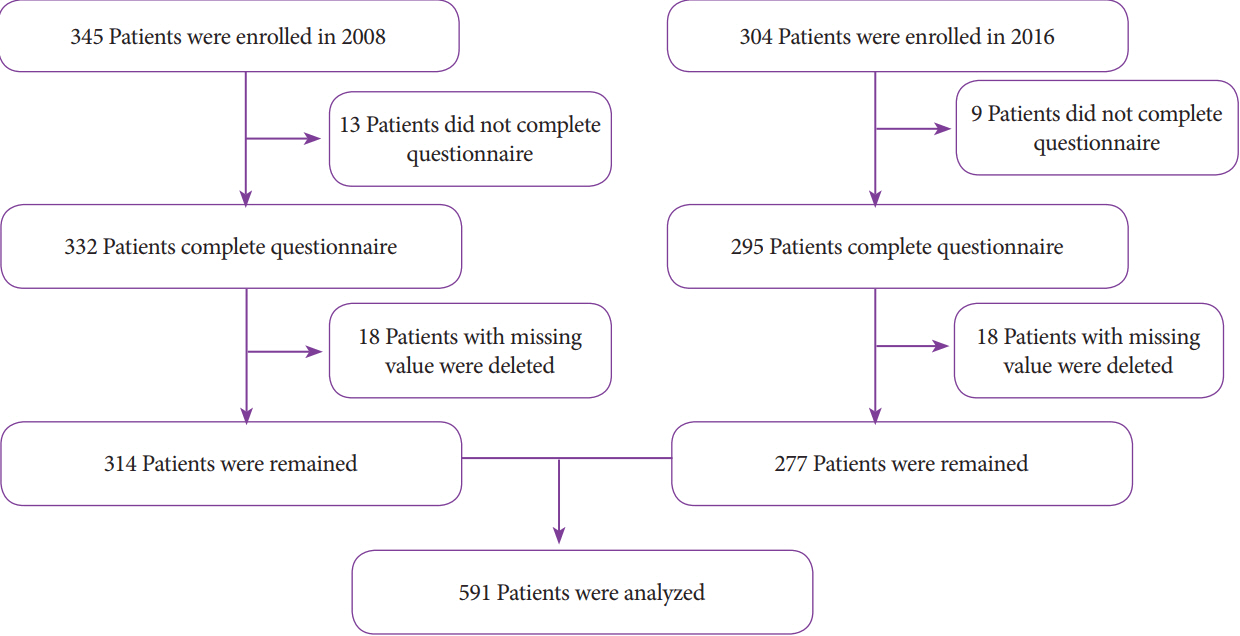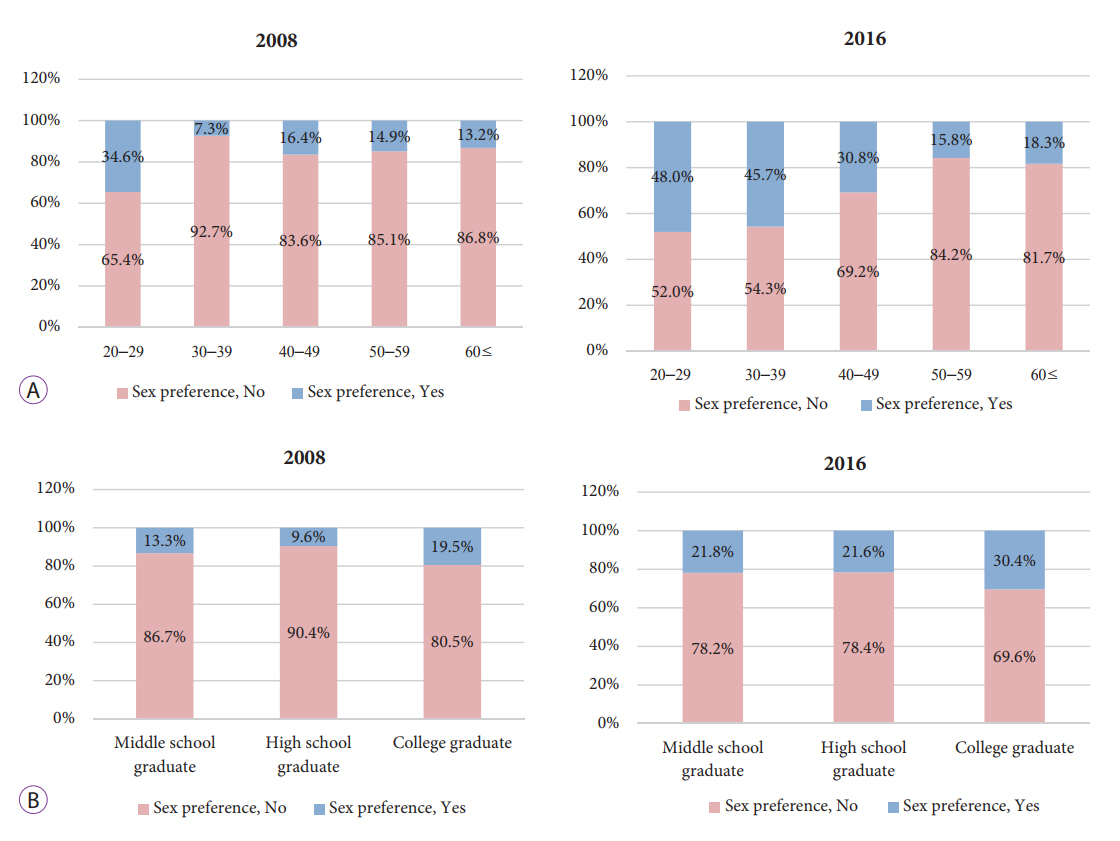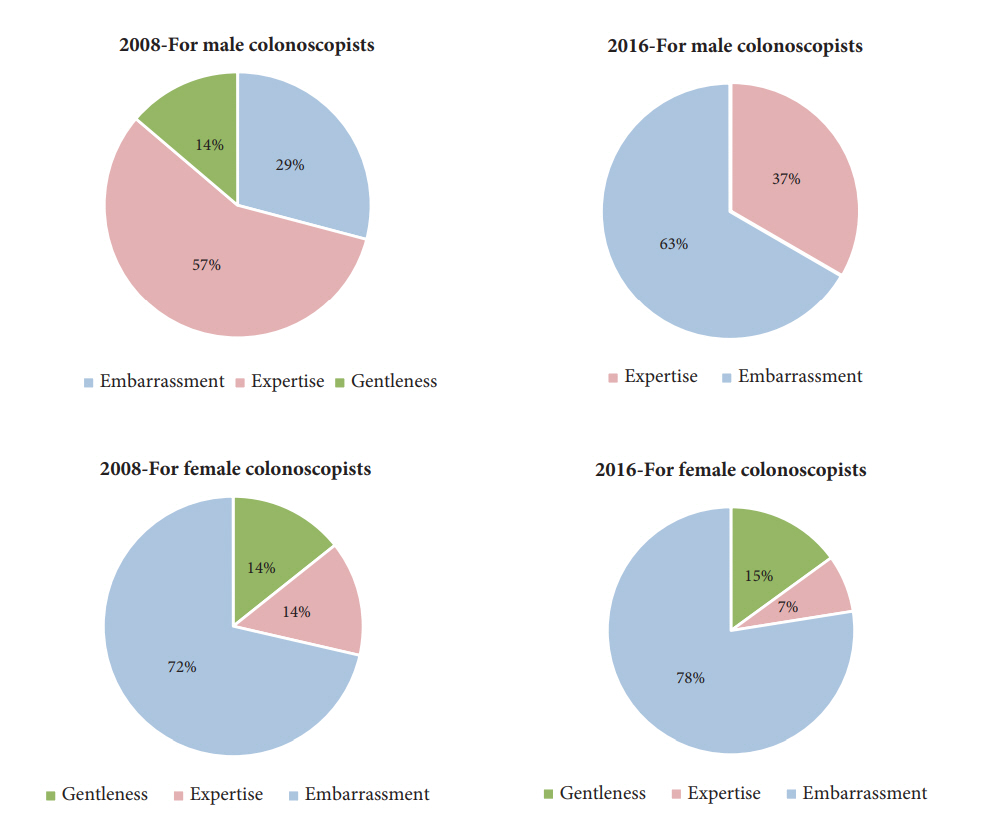Clin Endosc.
2018 Jan;51(1):72-79. 10.5946/ce.2017.057.
Is There a Change in Patient Preference for a Female Colonoscopist during the Last Decade in Korea?
- Affiliations
-
- 1Division of Gastroenterology and Hepatology, Department of Internal Medicine, Institute of Gastrointestinal Medical Instrument Research, Korea University College of Medicine, Seoul, Korea. drchunhj@chol.com
- KMID: 2403636
- DOI: http://doi.org/10.5946/ce.2017.057
Abstract
- BACKGROUND/AIMS
Patients may feel embarrassed during colonoscopy. Our study aimed to assess changes in patient preference, over the past decade, for the sex of their colonoscopist.
METHODS
Prospective studies were performed at a single health center from July to September 2008, and from July to September 2016. Subjects included colonoscopy patients (2008: 354, 2016: 304) who were asked to complete a questionnaire before colonoscopy.
RESULTS
In 2016, 69 patients (24.9%) expressed a sex preference, compared with 46 patients (14.6%) in 2008. By 2016, female patient preference for a female colonoscopist had significantly increased to 95% (odds ratio [OR], 2.678; 95% confidence interval [CI], 1.418- 5.057; P=0.002). In multivariate analysis, patient sex (OR, 4.404; P=0.000), patient age (OR, 0.977; 95% CI, 0.961-0.992; P=0.004), and year of procedure (OR, 1.674; 95% CI, 1.028-2.752) were statistically significant factors in sex preference. Between 2008 and 2016, female patients preferred a female colonoscopist because of embarrassment. Male patients also preferred a male colonoscopist, and the primary reason shifted from expertise to patient embarrassment (2008: 29%, 2016: 63%).
CONCLUSIONS
Patients have an increased gender preference for the colonoscopist because of embarrassment. Taking this into account can increase patient satisfaction during colonoscopy.
Keyword
MeSH Terms
Figure
Reference
-
1. Winawer SJ, Zauber AG, Ho MN, et al. The national polyp study. Eur J Cancer Prev. 1993; 2 Suppl 2:83–87.
Article2. Varadarajulu S, Petruff C, Ramsey WH. Patient preferences for gender of endoscopists. Gastrointest Endosc. 2002; 56:170–173.
Article3. Fidler H, Hartnett A, Cheng Man K, Derbyshire I, Sheil M. Sex and familiarity of colonoscopists: patient preferences. Endoscopy. 2000; 32:481–482.
Article4. Menees SB, Inadomi JM, Korsnes S, Elta GH. Women patients’ preference for women physicians is a barrier to colon cancer screening. Gastrointest Endosc. 2005; 62:219–223.
Article5. Christie J. One size does not fit all. Gastrointest Endosc. 2008; 67:278–279.
Article6. Shah DK, Karasek V, Gerkin RD, Ramirez FC, Young MA. Sex preferences for colonoscopists and GI physicians among patients and health care professionals. Gastrointest Endosc. 2011; 74:122–127.e2.
Article7. Kim JH, Lee JH, Park EH, et al. Patients’ gender preference for colonoscopist. Korean J Gastrointest Endosc. 2005; 31:25–31.8. Lee SY, Yu SK, Kim JH, et al. Link between a preference for women colonoscopists and social status in Korean women. Gastrointest Endosc. 2008; 67:273–277.
Article9. Govender V, Penn-Kekana L. Gender biases and discrimination: a review of health care interpersonal interactions Glob Public Health. 2008; 3(Suppl 1):90–103.10. Kerssens JJ, Bensing JM, Andela MG. Patient preference for genders of health professionals. Soc Sci Med. 1997; 44:1531–1540.
Article11. Reid I. Patients’ preference for male or female breast surgeons: questionnaire study. BMJ. 1998; 317:1051.
Article12. Haar E, Halitsky V, Stricker G. Factors related to the preference for a female gynecologist. Med Care. 1975; 13:782–790.
Article13. Farraye FA, Wong M, Hurwitz S, et al. Barriers to endoscopic colorectal cancer screening: are women different from men? Am J Gastroenterol. 2004; 99:341–349.
Article14. Maynes K. Korean perceptions of chastity, gender roles, and libido; from kisaengs to the twenty first century. Grand Valley Journal of History. 2012; 1:Article 2.15. Schoen RE, Weissfeld JL, Bowen NJ, Switzer G, Baum A. Patient satisfaction with screening flexible sigmoidoscopy. Arch Intern Med. 2000; 160:1790–1796.
Article
- Full Text Links
- Actions
-
Cited
- CITED
-
- Close
- Share
- Similar articles
-
- Patients' Gender Preference for Colonoscopist
- The Colonoscopist's Expertise Affects the Characteristics of Detected Polyps
- Clinical Studies on 226 Cases of Stomach Cancer
- Patient Preference and Satisfaction in Decision-Making Process
- Preferences in Mental Health Services for Persons with Mental Illnesses: Q-Methodological Approach






